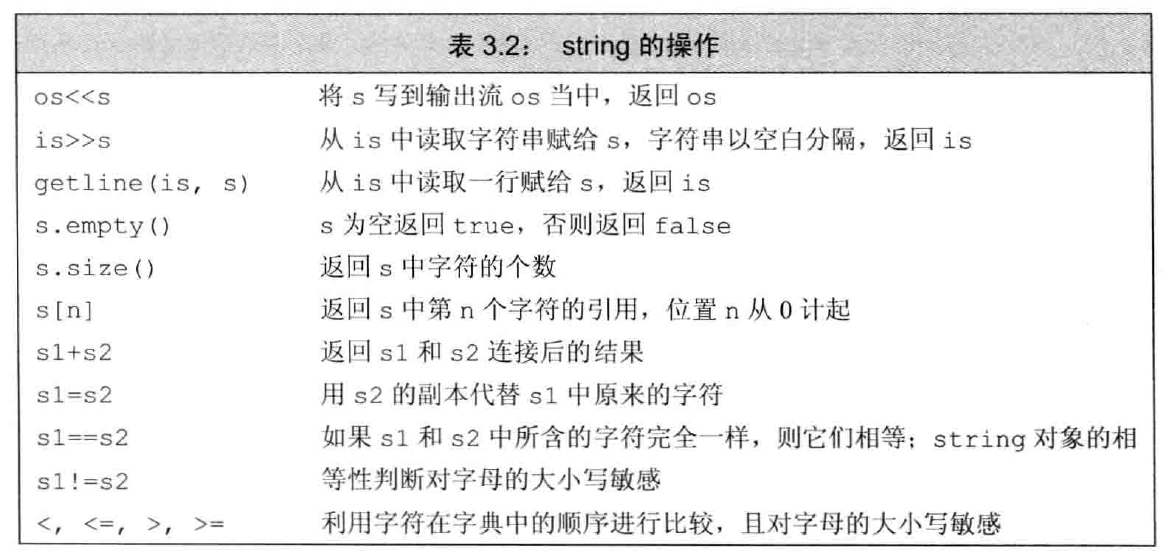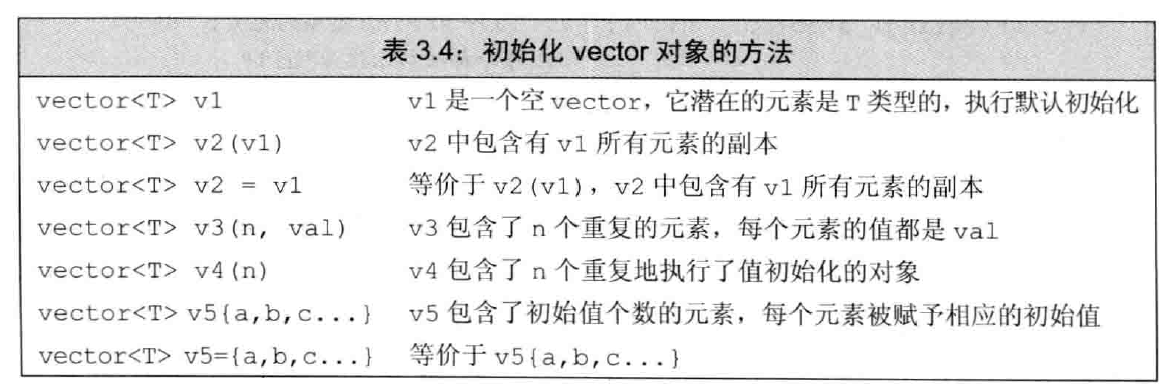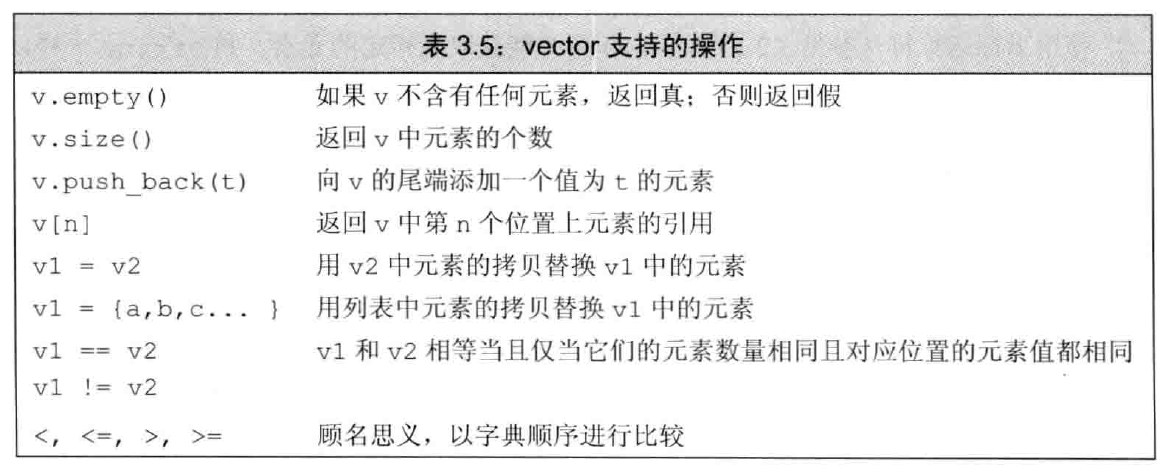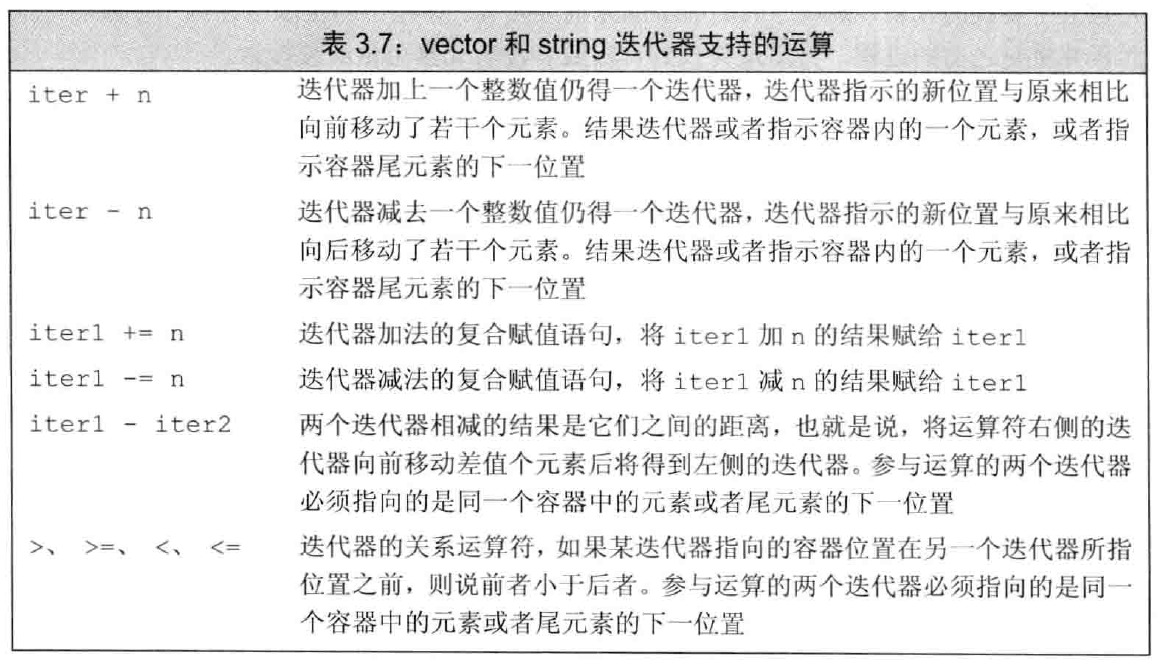C++ Primer Chapter 3 字符串、向量和数组
介绍标准库string和vector,以及迭代器和数组的使用。
命名空间的using声明
using namespace::name;头文件不应该包含using声明。
标准库类型string
string定义在命名空间std中。
#include <string>
using namespace std::string;定义和初始化
如果使用等号,实际上执行的是拷贝初始化。反之,执行的是直接初始化。

string对象上的操作

读写
执行读取操作时,会自动忽略开头的空白字符,直至遇到下一处空白。
输入" Hello World! ",输出则为"Hello"。
int main()
{
string s;
cin >> s;
cout << s << endl;
return 0;
}可以用getline读取一整行。
int main()
{
string line;
while (getline(cin, line))
cout << line << endl;
return 0;
}empty&size
empty判断string对象是否为空,返回bool。
while (getline(cin, line))
if (!line.empty())
cout << line << endl;size返回string对象的长度,类型为string::size_type。
while (getline(cin, line))
if (!line.empty())
cout << line.size() << endl;此时,空字符也会计数。
当使用size_type进行比较时,注意不要与int混用,因为负值的带符号数会转化为大整数的无符号数。
比较&加法
string对象逐字符比较,按字典序比较。
string s1 = "abc";
string s2 = "abc def";
string s3 = "abdef";
// res: s1 < s2 < s3两个string对象可以相加,字面值也可以和string对象相加。
string s1 = "hello", s2 = "world"。
string s3 = s1 + s2。
string s4 = s1 + " " + s2 + "\n";
string s5 = "hello" + " " + s2; // error运算时,应保证+两侧的运算对象至少有一个是string。
处理string中的字符
下表给出了一些关于字符属性的函数。

C++标准库为了兼容C,将C的头文件如name.h,命名为cname。
C++程序应该使用cname形式的头文件,以区分从C继承的头文件。
为了遍历string对象,可以使用下标,也可以使用范围for语句(推荐)。
string s = "hello world";
for (auto c : s)
cout << c << endl;如果想要改变字符,需要把循环变量定义为引用类型。
string s = "hello world";
for (auto &c : s)
c = toupper(c);
cout << s;有时候只需要处理部分字符,可以使用下标,也可以使用迭代器(后续介绍)。
// 实现单词首字母大写
string s = "hello world";
for (decltype(s.size()) index = 0;
index != s.size(); ++index) {
if (index == 0 && isalpha(s[index])) {
s[index] = toupper(s[index]);
continue;
}
else if (isalpha(s[index]) && !isalpha(s[index-1]))
s[index] = toupper(s[index]);
}
cout << s; // output: "Hello world"使用下标时,切忌下标越界,应该时刻检查下标的合法性。
标准库类型vector
vector表示相同类型对象的集合,每个对象都有一个索引用于访问对象。因此vector也被称为容器,vector同时也是一个类模板(距离还比较遥远)。
#include <vector>
using std::vector;模板实例化时,需要提供对象类型。
vector<int> ivec; // 元素是int
vector<vector<string>> file; // 元素是存放string的vectorvector作为类模板,不是类型。
引用不是对象,不存在包含引用的vector。
定义和初始化vector对象

注意区分列表初始化和元素数量。
vector<int> v1{10}; // 列表初始化,v1有1个元素,值为10。
vector<int> v2(10); // v2有10个元素,值为0。
vector<int> v3{10, 1}; // 列表初始化,v3有2个元素,值为10和1。
vector<int> v4(10, 1); // v4有10个元素,值为1。向vector对象添加元素
可以用vector的成员函数push_back添加元素。
vector<int> v;
for (int i = 0; i != 10; ++i)
v.push_back(i);与C不同,C++推荐先定义一个空的vector对象,运行时向其中添加具体值。
其他vector操作

vector同样支持范围for语句。
vector<int> v = {1, 2, 3, 4, 5};
for (auto &i : v) // 使用引用对vector的元素赋值
i *= 2;
for (auto i : v)
cout << i << " ";与string类似,vector的size函数返回类型为vector
// 统计各分数段内的人数
// input: 42 65 95 100 39 67 95 76 88 76 83 92 76 93 101
// output: 0 0 0 1 1 0 2 3 2 4 1
vector<unsigned> scores(11, 0);
unsigned grade = 0;
while (cin >> grade) {
if (grade <= 100)
++scores[grade/10];
else break;
}
for (auto i : scores)
cout << i << " ";迭代器介绍
使用迭代器
有迭代器的类型拥有名为begin和end的成员。
begin成员返回指向第一个元素的迭代器,end成员返回指向容器“尾后”元素的迭代器,通常被称作尾后迭代器。
如果容器为空,begin和end返回的是同一个迭代器,都是尾后迭代器。

string s = "hello world";
for (auto it = s.begin(); it != s.end(); ++it)
if (isalpha(*it))
*it = toupper(*it);C++习惯在for循环中使用!=进行判断,因为大多数迭代器都没有定义<运算符。
迭代器也有const类型,能读取但不能修改vector。
为了便捷,C++11引入了两个新函数cbegin和cend。
vector<int> v1;
const vector<int> v2;
auto it1 = v1.begin(); // type: vector<int>::iterator
auto it2 = v2.begin(); // type: vector<int>::const_iterator
auto it3 = v1.cbegin(); // type: vector<int>::const_iterator为了简化解引用和成员访问操作一起使用,C++定义了箭头运算符。
*it.empty; // error
(*it).empty;
it->empty;迭代器运算

// 得到最接近中间元素的迭代器
auto mid = v.begin() + v.size() / 2;C++定义了迭代器的差值,类型为difference_type。
// 二分搜索
vector<string> text;
string sought;
auto beg = text.begin(), end = text.end();
auto mid = text.begin() + (end - beg) / 2;
while (mid != end && *mid != sought) {
if (sought < *mid) // 在前半部分则忽略后半部分
end = mid;
else
beg = mid + 1; // 否则忽略前半部分
mid = beg + (end - beg) /2;
}数组
与vector不同,数组的大小确定不变,不能随意增加元素。
定义和初始化
数组的长度在编译时必须已知,所以维度必须是常量表达式。
定义数组时,必须指定类型,不能使用auto。和vector一样,不存在引用的数组。
unsigned cnt = 42;
constexpr unsigned sz = 42;
int arr[10];
int *parr[sz]; // 包含42个整型指针的数组
string bad[cnt]; // error数组也支持列表初始化,此时可以不指明长度,编译器会自动计算。
const unsigned sz = 3;
int ial[sz] = {0, 1, 2};
int a2[] = {0, 1, 2};
int a3[5] = {0, 1, 2}; // a3[] = {0, 1, 2, 0, 0}值得注意的是,在使用字符数组时,会在结尾添加一个空字符。
char a1[] = {'C', '+', '+'};
char a2[] = {'C', '+', '+', '\0'}; // 显式添加空字符
char a3[] = "C++"; // 自动添加空字符
char a4[6] = "Daniel"; // error上述表达式中,a1长度为3,a2和a3的长度都是4,a4长度应改为7。
数组不允许拷贝和赋值。
int a[] = {0, 1, 2};
int a2[] = a; // error
a2 = a; // error为了理解复杂的数组声明,可以从内向外阅读。
int *ptrs[10]; // 含有10个整型指针的数组
int &refs[10]; // 不存在引用的数组
int (*Parray)[10] = &arr; // Parray指向一个含有10个整数的数组
int (&arrRef)[10] = arr; // arrRef引用一个含有10个整数的数组
int *(&arry)[10] = ptrs; // arry是数组的引用,该数组含有10个指针访问数组元素
数组也可以用范围for语句或下标运算符访问。
数组下标被定义为size_t类型,定义在cstddef头文件中。
指针和数组
使用数组的时候,编译器一般会把它转换成指针。
string nums[] = {"one", "two", "three"};
string *p1 = &nums[0]; // p1指向nums的第一个元素
string *p2 = &nums; // p2和p1等价尽管能计算得到数组的尾后指针,但容易出错。C++11引入两个函数begin和end,与容器的同名成员功能类似。
int ia[] = {0, 1, 2, 3, 4, 5};
int *beg = begin(ia);
int *last = end(ia);与容器相似,指针相减的类型名为ptrdiff_t,也定义在cstddef中。
C风格字符串
尽管C++支持,但最好不好使用。

与旧代码的接口
允许使用字符串字面值初始化string对象,反过来则不行,需要使用c_str函数。
string s("hello world");
char *str = s; // error
const char *str = s.c_str();可以使用数组初始化vector对象
int int_arr[] = {0, 1, 2, 3, 4, 5};
vector<int> ivec(begin(int_arr), end(int_arr));C++应当尽量使用vector和迭代器,而非内置数组和指针;应当尽量使用string,而非C风格字符串。
多维数组
多维数组实际上就是数组的数组。
int ia1[3][4] = {
{0, 1, 2, 3},
{4, 5, 6, 7},
{8, 9, 10, 11}
};
int ia2[3][4] = {0, 1, 2, 3, 4, 5, 6, 7, 8, 9, 10, 11};
int ia3[3][4] = {{ 0 }, { 1 }, { 2 }}; // 初始化每行的第一个元素
int ia4[3][4] = {0, 3, 6, 9}; // 初始化第一行可以通过下标运算符访问多维数组的元素。
constexpr size_t rowCnt = 3, colCnt = 4;
int ia[rowCnt][colCnt];
for (size_t i = 0; i != rowCnt; ++i) {
for (size_t j = 0; j != colCnt; ++j) {
ia[i][j] = i * colCnt + j;
}
}也可以用范围for语句访问,实现同样的效果。
size_t cnt = 0;
for (auto &row : ia) {
for (auto &col : row) {
col = cnt;
++cnt;
}
}因为循环中要赋值,所以选用引用类型。其实除了内层循环,其他所有循环的控制变量都应该是引用类型。
for (auto row : ia)
for (auto col : row)上面这段语句将无法通过编译,因为row不是引用类型,所以row的类型是int*。
int *ip[4]; // 整形指针的数组
int (*ip)[4]; // 指向含有4个整数的数组